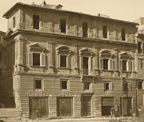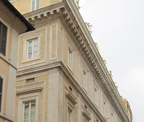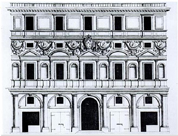RAPHAEL: THE ROMAN PERIOD BEETWEN PICTURE AND ARCHITECTURE
During the Roman period Raffaello painted for various clients about forty works, which today are exposed in major museums around the world.
| Among these works memorable is the portrait of Baldassare Castiglione, exposed at the Louvre. Raphael portraied Baldassare Castiglione also in the School of Athens in the likeness of Zoroaster. |
 |
Another famous portrait is that of Cardinal Tommaso Inghirami, who was also depicted in the School of Athens as Epicurus. There are two versions of the portrait, one exhibited in Florence, the other in Boston. |
 |
One of the characters portrayed in the Stanze was the Cardinal Bibbiena, great diplomatic but also a playwright. The canvas of 1516 is now in the Palatine Gallery in Florence. |
 |
| On the subject of altarpieces, for the innovative force and the extraordinary beauty, we must mention the Sistine Madonna, exhibited in Dresden Gemaldegalerie. in which the Virgin's face is that of Fornarina and the Pope is Julius II. |
 |
Finally, the theme of the Madonna and Child finds in the Madonna of the Chair, now in the Palatine Gallery in Florence, its highest expression |
 |
The work of Raphael as architect is not well known, but in 1514, at the death of Bramante, Leo X, with great disappointment of Michelangelo, entrusted him with the responsibility to design the new St. Peter's Basilica.
Raphael deeply committed himself, but as we know the death in 1520 prevented him from seeing the fulfillment of his efforts.
Then the Sack of Rome in 1527 stopped work for a long time, to be taken over by Michelangelo in 1546 and finally by Carlo Maderno in 1602.
It is interesting to observe the different projects, as derived from the plants of the church
As you can see, at the end, Carlo Maderno embraced the Latin cross solution by Raphael.
For a synthetic study click here.
Before being appointed superintendent of the Fabric of St. Peter, Raphael in 1509 designed the church of St. Eligius of Goldsmiths.
| Memorable is the harmony of the dome, but the curse of the Tiber has struck again, in fact because of the elevation of the levees to prevent floods, the church today is sunk to a level of about 4 meters below the embankment, as if enough over it is hanging the mass of the building of the high school Virgil |
 |
| In 1513 he designed the Chigi Chapel in Santa Maria del Popolo. |
 |
Again as architect Raphael designed Palazzo Jacopo da Brescia, which began in 1515 and ended in 1519.
| The Palace was demolished in 1936 to build Conciliazione street. It was rebuilt nearby not so well. Ancient photos show the Palace. |
 |
Always since 1515 to 1519 he designed Palazzo Alberini, in Santo Spirito street |
 |
In his last year of life Raphael designed Branconio dell’Aquila Palace, characterized by a highly innovative facade, which would have influenced the following Roman architecture.
The building was demolished in 1660 to make room for the square Rusticucci, now Piazza Pio XII (near the colonnade of St. Peter).
What remains of the palace are ancient prints and drawings by Raphael, with festoons of Giovanni da Udine. |
 |
His architectural work of more effort had to be Villa Madama, which he designed, since 1518, on behalf of Leo X and Giulio de’ Medici, the future Pope Clement VII.
Raphael involved in the work Antonio da Sangallo the Younger, who was already working with him at St. Peter, Baldassarre Peruzzi and Baccio Bandinelli. The workshop led by Giulio Romano, with Giovanni Francesco Penni, Giovanni da Udine, devoted himself to paintings and stucco decorations.
The project remained unfinished, not only for the death of Raphael, which, however, had left the designs of the Villa, but mainly because of the sack of Rome in 1527, when the villa was looted and set on fire. Following Clement VII scaled back the project by Raphael, which included a series of terraces sloping down to the Tiber.
| Raphael had studied in detail the insertion of the Villa in the environment, inspired by the ancient Roman Domus. |
 |
back |

